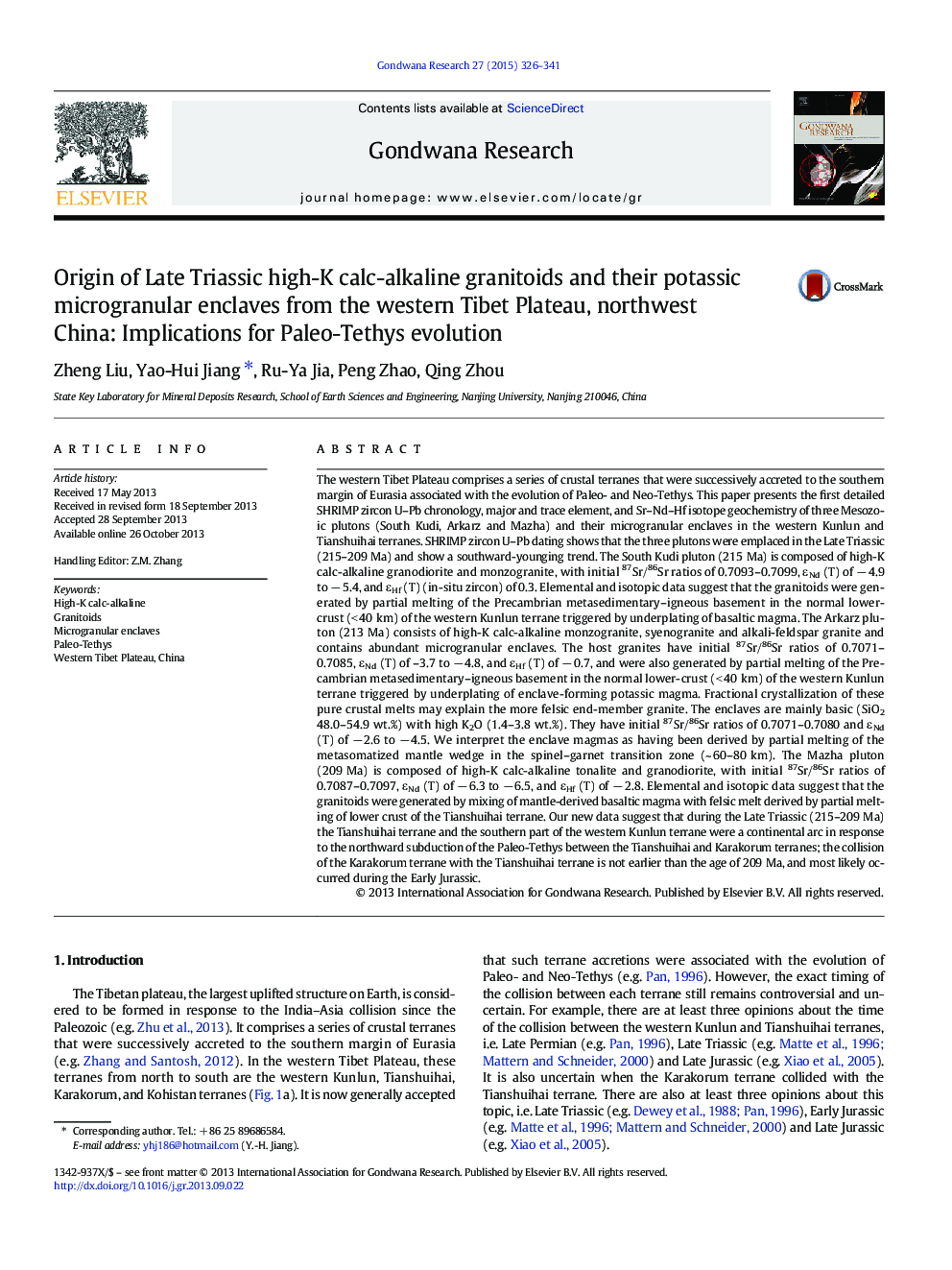| کد مقاله | کد نشریه | سال انتشار | مقاله انگلیسی | نسخه تمام متن |
|---|---|---|---|---|
| 4727190 | 1356364 | 2015 | 16 صفحه PDF | دانلود رایگان |
• We study three Mesozoic (215-209 Ma) granitic plutons in the W Tibet.
• They were formed in a continental arc setting.
• The closure of the Paleo-Tethyan ocean was not earlier than 209 Ma.
The western Tibet Plateau comprises a series of crustal terranes that were successively accreted to the southern margin of Eurasia associated with the evolution of Paleo- and Neo-Tethys. This paper presents the first detailed SHRIMP zircon U–Pb chronology, major and trace element, and Sr–Nd–Hf isotope geochemistry of three Mesozoic plutons (South Kudi, Arkarz and Mazha) and their microgranular enclaves in the western Kunlun and Tianshuihai terranes. SHRIMP zircon U–Pb dating shows that the three plutons were emplaced in the Late Triassic (215–209 Ma) and show a southward-younging trend. The South Kudi pluton (215 Ma) is composed of high-K calc-alkaline granodiorite and monzogranite, with initial 87Sr/86Sr ratios of 0.7093–0.7099, εNd (T) of − 4.9 to − 5.4, and εHf (T) (in-situ zircon) of 0.3. Elemental and isotopic data suggest that the granitoids were generated by partial melting of the Precambrian metasedimentary–igneous basement in the normal lower-crust (< 40 km) of the western Kunlun terrane triggered by underplating of basaltic magma. The Arkarz pluton (213 Ma) consists of high-K calc-alkaline monzogranite, syenogranite and alkali-feldspar granite and contains abundant microgranular enclaves. The host granites have initial 87Sr/86Sr ratios of 0.7071–0.7085, εNd (T) of –3.7 to − 4.8, and εHf (T) of − 0.7, and were also generated by partial melting of the Precambrian metasedimentary–igneous basement in the normal lower-crust (< 40 km) of the western Kunlun terrane triggered by underplating of enclave-forming potassic magma. Fractional crystallization of these pure crustal melts may explain the more felsic end-member granite. The enclaves are mainly basic (SiO2 48.0–54.9 wt.%) with high K2O (1.4–3.8 wt.%). They have initial 87Sr/86Sr ratios of 0.7071–0.7080 and εNd (T) of − 2.6 to − 4.5. We interpret the enclave magmas as having been derived by partial melting of the metasomatized mantle wedge in the spinel–garnet transition zone (~ 60–80 km). The Mazha pluton (209 Ma) is composed of high-K calc-alkaline tonalite and granodiorite, with initial 87Sr/86Sr ratios of 0.7087–0.7097, εNd (T) of − 6.3 to − 6.5, and εHf (T) of − 2.8. Elemental and isotopic data suggest that the granitoids were generated by mixing of mantle-derived basaltic magma with felsic melt derived by partial melting of lower crust of the Tianshuihai terrane. Our new data suggest that during the Late Triassic (215–209 Ma) the Tianshuihai terrane and the southern part of the western Kunlun terrane were a continental arc in response to the northward subduction of the Paleo-Tethys between the Tianshuihai and Karakorum terranes; the collision of the Karakorum terrane with the Tianshuihai terrane is not earlier than the age of 209 Ma, and most likely occurred during the Early Jurassic.
Figure optionsDownload as PowerPoint slide
Journal: Gondwana Research - Volume 27, Issue 1, January 2015, Pages 326–341
